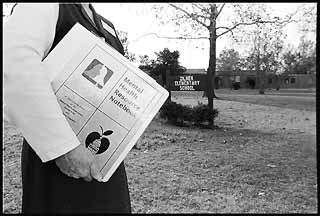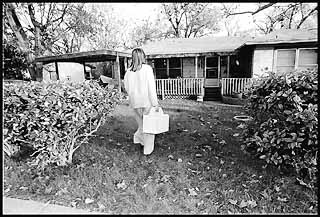Permanent Visitors?
Unique View
By Traci Terrill, Fri., Jan. 1, 1999
|
|
In a climate incredibly doubtful of the public school system's effectiveness, the Visiting Teachers have been able to maintain a unique and surprisingly hopeful perspective, providing a necessary bridge between the district and the maze of community and privately based social services outside the classroom. With the combination of prior teaching experience and training in social work and counseling, the Visiting Teachers have the capacity to understand the frustration of students, parents, and teachers.
The "teachers" share 10 cubicles at AISD's West Sixth St. headquarters. The small cubicles seem to shrink even more when two, sometimes three people need to share the tiny workspace. They refer to the meager doling out of office space lightly, almost affectionately, as being "cubbied up." Their schedules are unpredictable as they sift through a day of observing students, contacting parents, attending meetings, and working with service providers such as private agencies, Child Protective Services, juvenile courts, psychiatrists, teaching staff, and churches.
Each member of the group oversees six or seven schools -- that means more than 5,000 students ranging in age from three to 21 (the state cut-off point for high school seniors), their families, and school staff under their charge. Due to the broad scope of problems they must try to assuage, shifts in approach and observation must be swift, complete, and effective.
Visiting Teacher Elizabeth Hall has learned over the years to confront problems calmly, no matter the challenge. "One minute I'm in a high school and we've got a football player that can't read, but he has the chance to go on(to play football in college) and be a star," Hall said. The next minute she is responding to a 911 page, where there's been a car accident and a child has died. It can change that quickly. The whole day it's just boom, boom, boom, boom."
Her colleague, Sue Wall, has been with the program for 22 years. She has a master's degree in guidance counseling, a bachelor's in teaching, and certification as a public school teacher, school counselor, and a Visiting Teacher (the program requires its employees to take additional social work courses not mandatory for traditional school counselors). She is also a licensed professional counselor and licensed marriage and family therapist. In other words, Wall has had time and experience to assess the community's relationship to -- and opinion of -- the AISD school system.
Over the past decade the public has been encouraged to question everything that's happening in the school system, which is a positive step towards awareness, Wall said. Schools are unable to make positive changes without considerable help and attention from the community.
Budget Fears
|
|
At the beginning of last summer, after all AISD employees had been released for summer vacation, one of the Visiting Teachers happened to be watching the AISD Board of Trustees meetings on television. Much to her surprise, a board member suggested cutting five of the 15 Visiting Teacher positions. There was understandable panic from those involved with the program: If 15 bear the load of six or seven schools apiece, the load 10 would have to carry would be virtually impossible, they said. Immediately, the small group reached out to the community and friends in hopes of rallying support for their cause. Fortunately, they were able to convince the board; the proposal was not approved.
"We provide invaluable help to kids, but every year that's going to be an issue," said Wall, who has heard time and time again, "We don't really need more mental health workers within the district. Don't you see we have all these resources outside of the school system?"
Kathy Rider, AISD Board of Trustees president and a therapist herself, agrees that the Visiting Teachers program is extremely valuable and helpful to students and families in negotiating mental health resources. "The answer, of course, is not to try to focus on money, but on educational needs. We don't have as many [Visiting Teachers] as we need," Rider admits. "Without the number they have now, it would make it difficult to get services coordinated and make the whole process slower."
Rider blames the difficult funding situation the school board faces on the Chapter 41 state school funding formula. AISD is close to the point where a school district is deemed "rich" by the state and must by law share its tax wealth with less fortunate districts. Any district with at least $280,000 worth of taxable property per student is considered rich. If this happens, Rider says, cuts to district programs are likely.
"I don't want to alarm these people and make them feel like they are on the chopping block," said Rider. "It just all depends on Chapter 41."
The district's 1998-99 allocation for school community services, which includes the Visiting Teachers as well as community and parent education programs, volunteer services, the Communities in Schools program, and Absent Student Assistance Programs (ASAP) is about $7million of the $503 million AISD budget. A sizable portion of that is received through outside grants.
Although Wall agrees that social services exist outside of schools, they are not readily accessible to the general public. In fact, said Wall, with all services so spread out, and many depending on temporary grants and federal loans, it is imperative to create a more cohesive mental-health care umbrella within the school system.
Michael Cummings, coordinator of the state- funded Community Resource Coordination Group, which assists children in need from a variety of sources including juvenile courts, Child Protective Services and parents, believes the Visiting Teachers are invaluable in helping families negotiate the AISD system.
Many kids would fall through the cracks of the system if it weren't for the help of the Visiting Teachers, said Cummings. Many teachers and school counselors simply don't have the time to deal with children and their families outside of the school environment, he said.
"The Visiting Teachers expand concern for kids after the school day ends," said Cummings. "Without them, there would be a lot of kids out there who wouldn't get the attention they need."
The number of mental health professionals within the district has not kept up with Austin's booming population, and the overwhelming increase in students over the years. Subsequently, the small group of Visiting Teachers is constantly trying to deal with more and more very needy children. The number of Visiting Teachers has not only remained the same, but many are actually suggesting that AISD doesn't need as many people directly representing the school.
"Unfortunately, I think in education -- not only AISD, but public education in general -- there are a number of people who agree with the philosophy that schools are big businesses," said Wall. "But they are not businesses because schools don't handle inanimate objects; students are living, breathing human beings. Treating schools like businesses is in no way conducive to children learning."
Hall said the complicated and unpredictable grant and funding process for outside mental health agencies adds significantly to AISD's inconsistency in mental health services. Outside mental health services available to AISD students and families are not guaranteed to be there year after year and can disappear from legislative session to legislative session. The Visiting Teachers try to become as knowledgeable as possible about what mental health and social services are in the Austin community, but grants are constantly appearing and disappearing, and the rules that go with them create a huge net of confusion and inaccessibility for students and mental health workers alike.
"It's, 'Oh, if you live in this ZIP code you can use this service, but if you live in this ZIP code you can't,' or 'If you're over 12, you can use this service, but if you're under 12, you can't,' so there's no continuity," Hall said.
Bad Attitudes
|
|
Another challenge the employees in the Visiting Teachers program encounter is confronting the perception of public schools as a system mired in hopelessness and violence.
"I think that that is one of the things that's been talked so much about in the media it's kind of like it's become a fact," Wall said. "There are constantly things written implying that the whole [teaching] profession is incompetent," says Wall. "The negative stuff will always rise to the top, but that's superficial. I think [the negativity] is causing it to be harder and harder to find people who want to come into the profession."
Hall says this negativity even exists among those preparing others for careers in education. Following graduation from the University of Texas, Hall went immediately to teach at a local public high school. Eight years later she returned to UT to inquire about getting her masters. After hearing that she'd been teaching at a public school, one of the advisors at UT's Graduate School of Education said to Hall, "Wow, you've really been in the trenches," with a guffaw so strong and disgusted that he spit in her face. After that response, Hall opted to receive her master's at Southwest Texas State University.
"It's almost like I needed a Purple Heart," said Hall. "I was kind of shocked, but it illustrates an attitude towards public education in general."
A Shoulder to Cry On
Wall wants the community to realize that Visiting Teachers are not the courts, Child Protective Services, or the immigration authorities. The Visiting Teacher stands next to the parent and attempts to look at the problem with them, not judge them for having the problem in the first place. Wall says she approaches every student as if they are deserving of her respect, no matter who they are and how they live. But if someone she is trying to help doesn't want to talk to her, she will leave. She just provides them with options.
When a parent wails, Bown added, it means so much that there is someone nonjudgmental who is willing to just listen and say, "I hear you, I hear you." Most people they encounter will never bother to listen to what they have to say.
"There's just no room for negativity," Bown said. "It's like they've closed down the camera so tight that all they see is this tiny eye, and you help them open the aperture. That's the neat part about our role. And because we understand that role so well, there is an aura of communication."
That "aura" of open communication Bown believes in so strongly proved to be somewhat -- if not entirely -- effective in her experience with the pregnant 14-year-old girl. Although the girl has not returned to school, Bown arranged for a teacher to tutor her at home, and Bown is currently working on having the girl transferred to Travis High School, where daycare is provided for students with children.
The Visiting Teachers Program has remained a small program that has touched many lives. With this kind of dedication, perhaps the importance of school-based counseling and communication will not fall by the wayside in the future. The Visiting Teachers hope, for the sake of the thousands of students, families, and AISD staff who depend on their support, that this doesn't happen.
"Unless people know about groups like the Visiting Teachers Program," said Wall, "they won't know how important it is to keep them."
The Visiting Teachers are satisfied with their quiet good works. It's not a flashy job, and sometimes explaining what they do is hard to articulate to others. But they are proud of their work, and take seriously their responsibility for taking one entity and putting it together with another entity. After all, those connections often generate some powerful things.
"It's like the wonderful phrase, 'There but for the grace of God go I,'" said Bown. "That is so true. Somehow those of us who have been blessed with the counseling point of view really deeply recognize that."
Got something to say on the subject? Send a letter to the editor.









